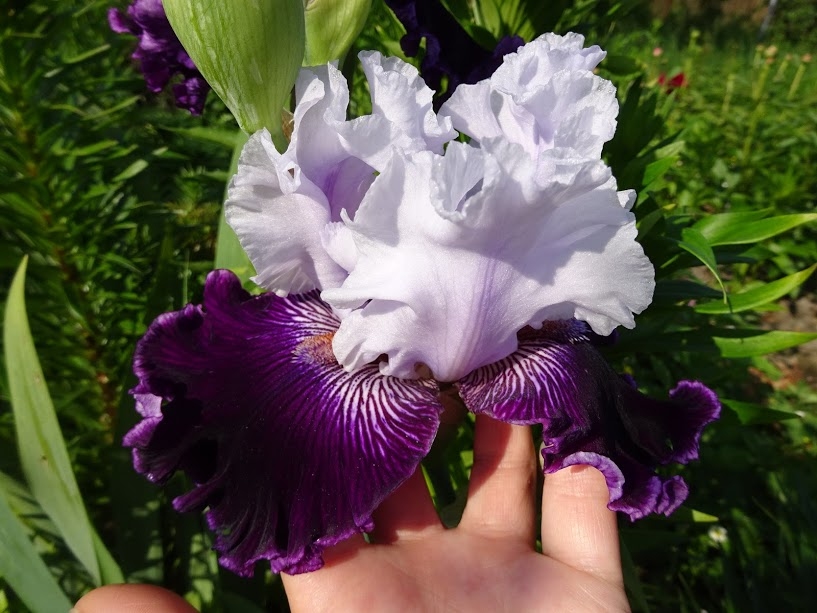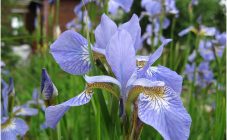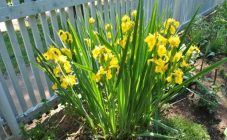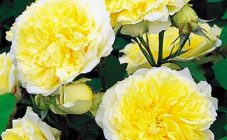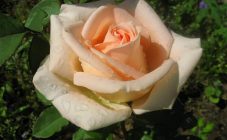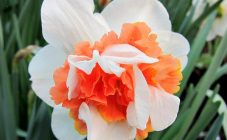Iris are bred because of the unusual shape and color of the flowers. The plant grows well in sunlit areas or in the shade of trees. They use it in perfumery.
Popular varieties
Due to the large number of species, novice summer residents are lost when choosing a particular type of iris for the garden. The most popular of them are currently considered:
- Cloud Ballet has a nice blue and white color. It is a bearded plant type that is characteristic of Europe and Asia.
- Back in Black - its flower is painted in dark purple tones. Its height ranges from 70-80 cm.
- Dwarf varietal irises rise 20-40 cm high. They are used to decorate small flower beds. Among these varieties, the most popular are Cry Baby with blue flowers, they turn white due to burnout in the sun, and Little Dream, whose color varies from lilac to blue.
- Bulbous irises are distinguished by their early flowering period. Their buds bloom immediately after the snow melts. The height of flowers of this type ranges from 10-30 cm. The names of the most common species are: Vinogradov's reticulated iris, Dutch Ksifium, etc. They are bred in pots, and gazebos are decorated with plants.
- The purple-colored Delavayi variety differs in flower shape. Its height does not exceed 50-60 cm. Another popular variety of Siberian irises is Dykesii. It stretches up to 90 cm, and its petals on the bud are alternately colored blue and purple.
- Swamp varietal irises have leaves shaped like a sword. Plant height ranges from 40 to 60 cm. Such species as Black Form with double flowers and Veriegata with blue buds are widespread.
- Iris Fashion Statement belongs to the family of bearded types. Its height ranges from 70-90 cm. It has an average growing season (spring-autumn). Iris Fashion Statement flower has light lilac petals.
- Growing well on summer cottages in central Russia, the representative of the bearded iris Dinner talk has buds painted in white and lilac shades. Its stem height reaches 80 cm. This hybrid has recently appeared on the market. Iris Diner is a good choice for creating landscape flower beds in parks and squares, although it can also be grown to decorate a summer cottage.
- Iris Mattinata belongs to the dwarf species. Its height does not exceed 30 cm. The petals are painted lilac-blue. The flower grows well at home.
- Iris Hollywood Night has small spray patterns under the beards. The peduncle rises up to 75-80 cm. The petals are painted in purple-black tones. And in the Hollywood Knight iris, they are strongly corrugated and twisted, which sharply distinguishes it from other bearded species.
- Iris Delta Blues belongs to the same type of flowers, the height of which ranges from 80-90 cm. It has an average time of development of a flower colored in lilac and blue tones.
- Iris Ensata belongs to the marsh species with xiphoid leaves. It rises to a height of 15 cm. Its flowers are purple.
- Iris Pirate Cove has petals of lilac, lilac-creamy, and light purple tones. Differs in average growth - up to 40 cm. Ripens by the end of summer.
- Iris Compliment belongs to the family of bearded flowers. Its height ranges from 30 to 60 cm, the color is lilac or purple.
Together with these varieties, Japanese irises are bred in the gardens, for example, the Phantom of Happiness or the tall (110 cm) Vasily Alferov.
It is almost impossible to give a description of all types of irises that farmers plant on their plots. This is a small part of all the iris varieties that people plant on their plots.Every year growers bring new hybrids of these attractive flowers onto the market.
Iris care, diseases and pests
When planting flowers such as Back in Black and others, it must be borne in mind that they do not like a lot of moisture and excess fertilizer. A summer resident is recommended to choose large rhizomes when buying.
Bearded varietal irises like Cloud Ballet should be planted in the last month of summer. The soil must be neutral, otherwise the irises will not bloom.
When planting rhizomes, the earth is dug up to the size of a shovel bayonet. A little fertilizer is introduced into it 6-7 days before the operation. If groundwater passes nearby, a drainage system is made.
Leave 0.4 m between plants for growth. After planting, future flowers are watered with warm water. The next stage of hydration occurs in 3-4 days.
If bulbous species, for example, Xyphyum or Dunford's iris, are bred, loose, sunlit rocky areas are selected for them. Planting dates are early and mid-autumn. The bulbs are buried in the ground by 2 of their sizes.
Caring for bearded varietal irises and other plant varieties involves the timely weeding of the beds from weeds. They are destroyed by hand. Loosening is carried out carefully due to the close location of the roots to the surface of the earth. Flowers are watered 2 times a week. Fertilizers are applied 3 times a season: in spring, when buds form, and then at the end of summer.
If flowers, for example, Iris Sea Power, are attacked by garden pests (nematodes, May beetle), the flowers are sprayed once every 15 days with preparations that kill insects. If slugs are picked up on the Sea power iris, they are chased away by treating the soil and stems with wood ash.
For diseases with rot, plants are cleaned of affected tissues, then treated with Bordeaux liquid. The area of soil on which the flower grew is also removed. Spot and other lesions are eliminated with special agents that destroy bacteria and fungi.
Planting, caring for and growing a variety of flower hybrids allows most farmers and urban dwellers to decorate their habitat. Every year new varieties of irises appear, so you need to choose them based on the aesthetic preferences and financial capabilities of the gardener. If he is confused in the variety of these representatives of the flora, it is better to consult a specialist or an experienced grower who will help you choose the right variety suitable for a particular site.

